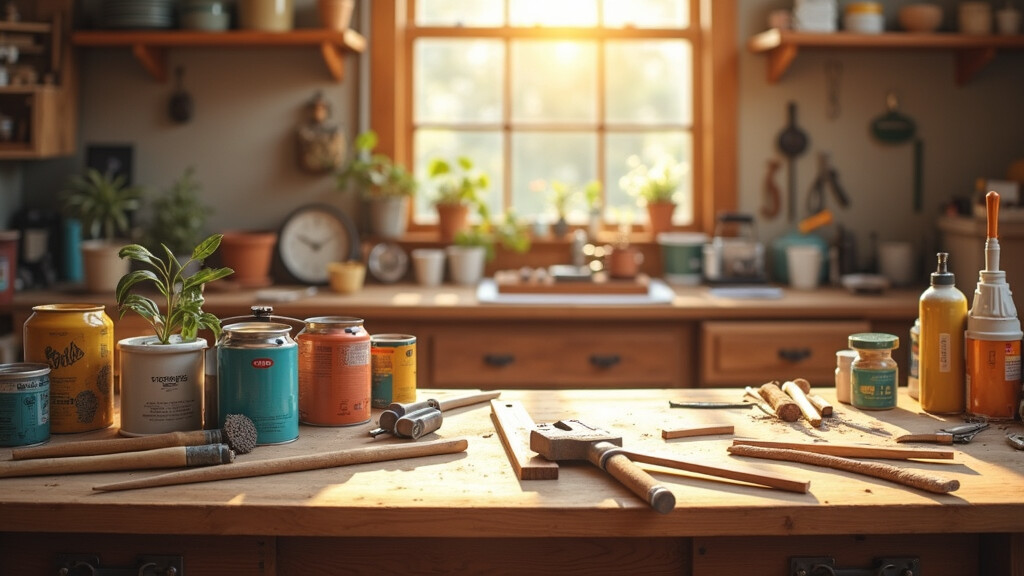
DIY projects are an excellent way to keep money in my pocket. Whether I’m fixing up something old, making new decor from leftovers, or handling minor repairs on my own, doing things myself helps cut costs and gives me more control over the results. Getting started doesn’t require fancy skills or expensive tools—just a bit of curiosity and a willingness to try. Here, I’ll walk you through how to make DIY work for your wallet and point out project ideas that have made a real difference for me.
How DIY Projects Lead to Real Savings
DIY means “do-it-yourself,” and the idea is straightforward. Instead of hiring someone or buying something brand new, I handle the job myself. This can mean painting a wall, building shelves, sewing curtains, repairing an appliance, or even upcycling old furniture. By skipping labor fees and buying materials directly, the upfront costs are usually much lower. In the long run, these small savings add up and can noticeably cut your annual household expenses.
The flexibility DIY offers appeals to me too. I get to choose the finish or style I want, work at my natural pace, and address urgent fixes immediately. Relying on myself for home repairs, yard work, or even holiday gifts means I avoid service charges, shipping costs, and inflated prices from middlemen. It adds up to real savings and a sense of competence.
Popular Money-Saving DIY Projects
Over the years, I’ve noticed certain types of projects regularly save money for me and others who give them a shot. If you need inspiration, these categories are perfect places to start:
- Home Repairs and Maintenance: Handling small leaks, recaulk a tub, patch drywall, or paint a room may sound basic, but they cost much less when you do them on your own.
- Homemade Decor: Simple updates—like making your own picture frames, refurbishing old lamps, or sewing pillow covers—can refresh a room for just a fraction of the cost of new items.
- Furniture Upcycling: Instead of throwing out old tables or dressers, sanding and painting them can turn them into eye-catching showpieces, plus you’ll save by not buying replacements.
- Energy Efficiency Upgrades: Projects like adding weatherstripping, switching to LED lights, or sealing windows cut utility bills and cost little to accomplish yourself.
- Gifts and Cards: Making candles, bath salts, or personalized cards helps me spend less during holidays and special occasions, and the gifts feel more personal.
Each of these categories can fit different budgets and skills. I suggest starting with the projects that seem manageable and growing your abilities as you try more.
Getting Started: Easy Projects to Make and Save
New to DIY? Picking straightforward projects is the best way to gain confidence. Here are a few beginner ideas I’ve tried that offer solid savings and quick, noticeable results:
- Painting Walls: Rather than hiring a pro, I buy quality paint and cheap brushes. After taping edges and moving furniture, painting is direct and satisfying.
- Installing Weatherstripping: Gaps around doors and windows raise energy bills. I pick up adhesive foam or silicone weatherstripping at the hardware store. In less than an hour, comfort goes up and costs go down.
- Patching Minor Drywall Holes: Dents and small holes from hanging pictures or moving furniture can simply be covered with putty and sandpaper. Doing this myself saves on hiring someone for minor fixes.
- Building Simple Shelves: I use leftover wood or low-cost boards to make shelves that fit my needs, which saves on store-bought shelving while improving organization in my home.
- Crafting Homemade Cleaning Products: Mixing vinegar, baking soda, and castile soap is inexpensive. These homemade cleaners work just as well as brand names without extra additives.
Trying these projects first can shrink household expenses and give DIY skills a boost for the future. The pride in finishing a task yourself is a rewarding bonus.
Tips to Keep DIY Affordable and Stress-Free
No one enjoys projects that run way over budget or are harder than expected. I’ve picked up some steps to keep things easy on the wallet and schedule:
- Plan and Budget: I always list out supplies, check what I already have, and estimate my costs. This helps avoid duplicate purchases and surprise expenses.
- Start Small: I stick to projects that fit my current skill set. Confidence and skill grow with practice, making bigger tasks easier down the line.
- Find Tutorials: Free resources on YouTube, home blogs, and local library guides are invaluable for learning tricks and avoiding common mistakes.
- Borrow Tools When Possible: Purchasing every tool upfront gets pricey in a hurry. I borrow from friends or rent from hardware stores, saving space and money.
- Smart Material Sourcing: Thrift shops, recycling centers, and online listings often have good quality used wood, hardware, or paints for less than new supplies.
With a bit of planning, these strategies help me finish more projects, stick to my budget, and enjoy what I’ve built while saving money.
Important Things to Think About Before Taking On a DIY Project
No project is pain-free. I’ve learned to look over a few key points before starting any DIY job so I don’t run into bad surprises:
- Skill Level: I ask if I honestly have the know-how for the work. Electrical wiring or plumbing repairs are often safer to leave to professionals.
- Time Commitment: I make sure I have enough free time to finish. Half-done projects lying around can lead to higher costs later to fix what’s left undone.
- Hidden Costs: Small jobs can reveal big hidden problems. I build a little extra budget for fixing any surprises, like finding water damage during a door frame repair.
- Safety: Gloves, goggles, and reading tool instructions before starting are small steps that keep me out of trouble. I never skip safety measures, especially with tools or chemicals.
This preparation means I can handle obstacles better and get more bang for my buck with each project.
Skill Level
It’s best to be candid about what I can tackle. Painting and basic woodworking are doable for almost anyone, while more advanced work like electrical or tough plumbing jobs really should involve an expert. Sometimes community workshops or local home centers offer affordable how-to classes for trickier repairs.
Time Commitment
DIY jobs take time, mostly on the first attempt. Rushing means more mistakes and extra costs. I check each project’s steps and block out real time on my calendar to make sure I can complete what I start.
Hidden Costs
Even the simplest job can reveal extra work. When I fixed a jammed door, I realized water damage had warped the frame. Having a bit of budget wiggle room meant I could buy the right materials and finish the job well under what a pro would have charged.
Safety
Small injuries set back progress. I keep a first aid kit nearby and double-check all instructions. For cleaners and finishes, proper ventilation matters, and I take breaks when needed to avoid fatigue-related mistakes.
Most projects come off smooth when I double-check plans and safety steps ahead of time. Doing things yourself is practical for almost anyone willing to prepare.
Advanced DIY Projects That Multiply Savings
After learning the basics, I look around for chances to take up my DIY skills. These intermediate projects often result in long-term savings and improve both function and value around my home:
Install New Light Fixtures: Replacing outdated lights with modern, energy-saving LED fixtures cuts monthly utility costs and gives spaces a new look.
Tile a Backsplash: Adding a backsplash in kitchens or baths keeps walls protected and brings next-level cool for a much lower price than hiring a contractor.
Refurbish Appliances: Appliances that sputter or stop working sometimes only need a new part or a cleaning. Looking up repair tutorials before replacing an expensive item can lead to big savings.
Build Raised Garden Beds: Growing my own vegetables from seeds or cuttings stretches grocery dollars, plus the produce is fresh and satisfying to share.
Tackling these bigger jobs boosts confidence and keeps my home looking good while actively saving money.
Frequently Asked Questions
People often wonder the same things before jumping into DIY projects. Here are some common questions answered:
Question: What are the most cost-effective DIY projects for beginners?
Answer: Painting, sealing up gaps with weatherstripping, and making DIY cleaning products usually offer big savings and don’t require rare tools or skills.
Question: How do I keep from feeling overwhelmed by a project?
Answer: Breaking tasks into bite-sized daily goals with a checklist makes projects manageable and prevents frustration.
Question: Where can I score cheap materials?
Answer: I often stumble upon deals at thrift stores, hardware store clearance sections, and online listings for leftover lumber or lightly used supplies.
Why DIY is a Reliable Way to Save
In the end, I’ve noticed that DIY is more than just about saving cash. Working on projects myself helps me build skills, gain confidence, and shape things exactly the way I want them. The money saved adds up fast, but so does the satisfaction from seeing what I can do with my own hands. Even simple fixes give homes a personal touch and make life a bit easier.
If you’re on the fence about tackling your own projects, I encourage you to jump in. Everyone starts somewhere, and kicking things off with small tasks is a solid way to build momentum—plus, both your wallet and your sense of accomplishment will thank you.

Thank you for this very useful guide and breaking down not just the cost-saving benefits of DIY, but also the practical mindset behind getting started. I especially appreciated the emphasis on honestly assessing your skill level and factoring in hidden costs, which I have often overlooked myself in many DIY projects. Your real life example of discovering water damage behind a door frame hit home for me something similar happened when I tried to replace a towel rack and uncovered crumbling drywall behind it!
Have you ever had a DIY project that completely didn’t go as planned, or one where you had to call in a professional midway through? I think stories like that can be just as valuable for people who are weighing the risks of trying something new.
Also, your section on energy efficiency upgrades got me thinking, have you tried any energy saving installations? Would love to hear if those were worth the time and effort.
I’ve never had to call in a pro to bail me out, but that can happen if you get in over your head. It’s best to start with the easiest projects, so you know you’ll be able to complete them (or at least not damage anything, lol). I’d also recommend finding more than one resource for learning how to do something. If you’re learning from a youtube video, for example, try to find 2 or 3 others, because no situation is exactly alike and the more approaches you see in action on video, the easier it will be to determine what to watch out for before it’s too late.
And don’t forget AI! You can always ask chatgpt, or whichever is your favorite, for advice on how to proceed, where to find the best tutorials, and whether or not that specific project is suitable for a novice. The key with AI is just asking it like you’re asking another human being. Just include as many specifics as you can and ask very thorough questions with follow-ups. You’d be surprised at the guidance you can get this way.
Mark